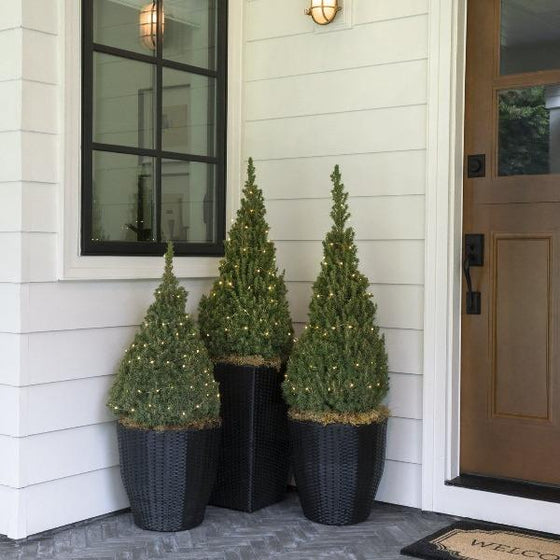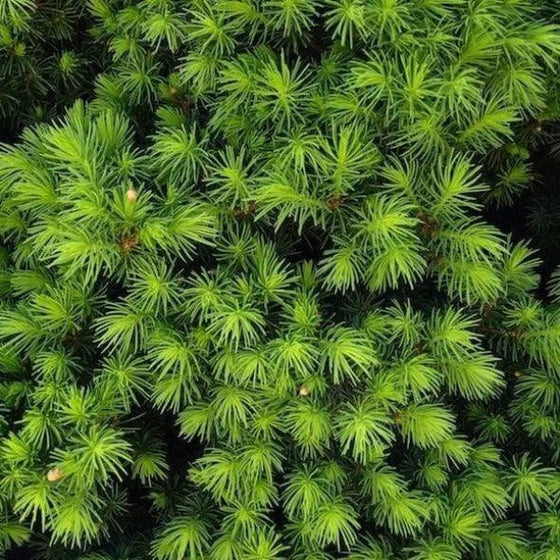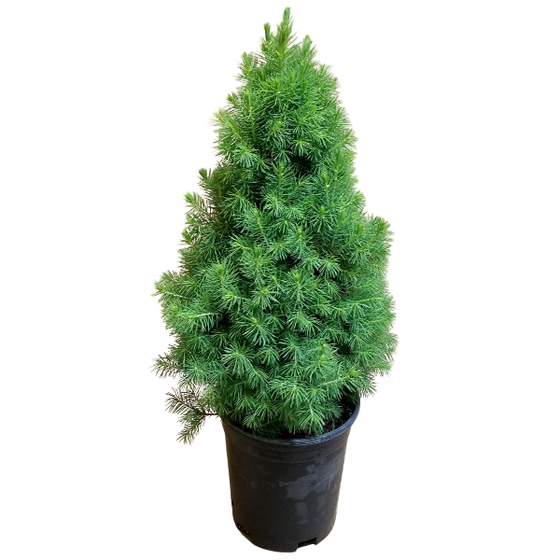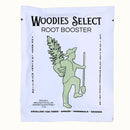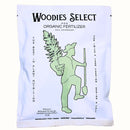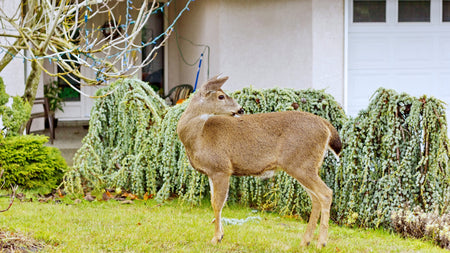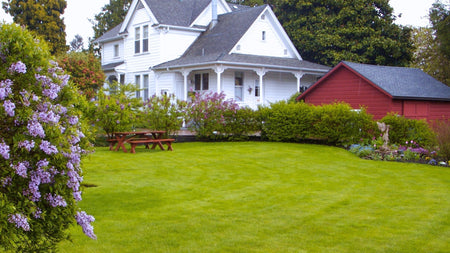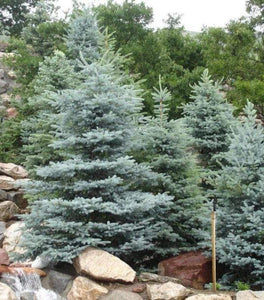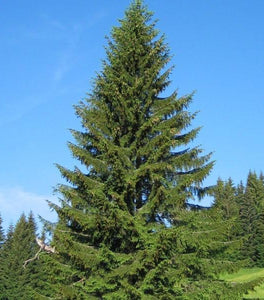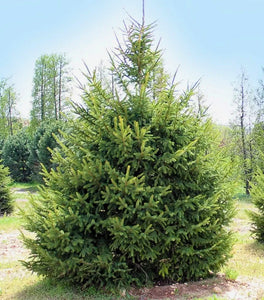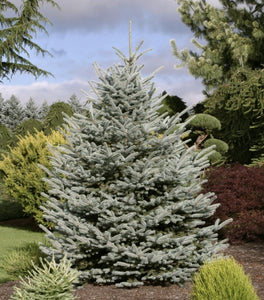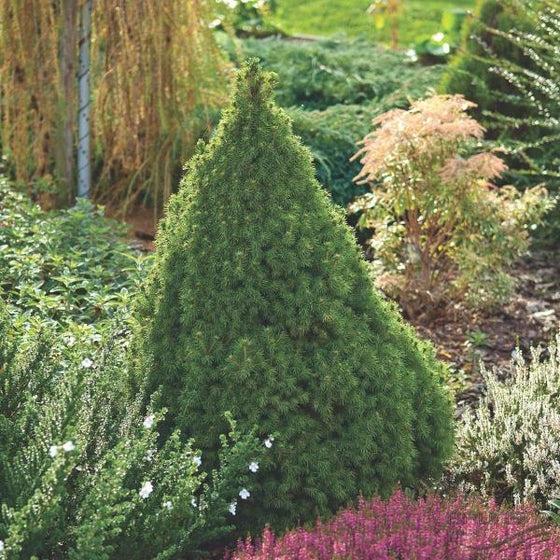
Images Depict Mature Plants
Dwarf Alberta Spruce Trees
Dwarf Alberta Spruce Trees (Picea glauca ‘Conica’) are beloved for their compact, symmetrical shape and dense, bright green needles that provide year-round interest. Naturally growing in a conical form, these slow-growing evergreen trees are ideal for formal gardens, foundation plantings, and decorative containers. Reaching a mature height of 6 to 8 feet over many years, Dwarf Alberta Spruce offers an elegant, low-maintenance option for adding vertical interest to tight spaces.
These cold-hardy evergreens thrive in full sun and well-drained soil, adapting well to both urban and suburban landscapes. Their tidy, pyramidal shape requires little to no pruning, making them especially popular for entryway accents, topiary forms, or symmetrical planting in pairs. Dwarf Alberta Spruce maintains its soft texture and fresh green color throughout the seasons, bringing consistent charm to mixed borders, rock gardens, or container displays.
Gardeners appreciate Dwarf Alberta Spruce Trees not only for their visual appeal but also for their durability and resilience. They are resistant to many pests and tolerant of cold climates, making them a smart long-term investment in your landscape design. Whether planted as a single specimen or in a symmetrical row, these compact conifers bring structure, texture, and timeless evergreen beauty to any outdoor space.

| Hardiness Zone: | 3-8 |
|---|---|
| Mature Height: | 6 to 8 Feet |
| Mature Width: | 4 to 5 Feet |
| Classification: | Conifer / evergreen |
| Sunlight: | Partial to full sun |
| Habit: | Densely branched, cone-shaped |
| Foliage: | Dark green |
| Flower Color: | Inconspicuous |
| Pruning Season: | Prune in late spring to maintain shape |
| Soil Condition: | Any well-drained soil |
| Water Requirements: | Water well until established |
| Uses: | Extremely attractive when used as in the mixed border, foundations, or planted in mass |
How to Care for Dwarf Alberta Spruce
Before you buy a Dwarf Alberta Spruce Tree, make sure to read about the recommended care instructions to keep this plant healthy and thriving.
How do I plant my Dwarf Alberta Spruce Tree?
To plant your Dwarf Alberta Spruce Tree, begin by selecting a site that receives full sun to partial shade and offers well-drained soil. These compact evergreens thrive in slightly acidic to neutral soil and do not tolerate soggy conditions. Dig a hole twice as wide and as deep as the root ball, loosening the surrounding soil to encourage root expansion. Gently remove the tree from its container, tease apart any circling roots, and position it so the top of the root ball is level with the surrounding soil. Backfill with native soil mixed with compost, pressing gently to eliminate air pockets, and water thoroughly after planting. Once planted, apply a 2- to 3-inch layer of organic mulch around the base—keeping it away from the trunk—to help retain moisture and suppress weeds. Space multiple Dwarf Alberta Spruce Trees 4 to 6 feet apart if planting in a row or symmetrical grouping. These trees are excellent choices for containers, entryway flanking, and small-space gardens thanks to their slow growth and natural conical form. With proper planting and location, your Dwarf Alberta Spruce will establish quickly and provide lasting evergreen appeal for years to come.
How often do I water my Dwarf Alberta Spruce trees?
Proper watering is essential for the health and longevity of your Dwarf Alberta Spruce Tree, especially during its first year after planting. Immediately after planting, water deeply to saturate the root ball and surrounding soil. During the growing season, maintain consistent soil moisture by watering when the top inch of soil feels dry—typically once or twice per week, depending on weather conditions. Avoid overwatering, as soggy or poorly drained soil can lead to root rot. A slow, deep soak is best to encourage strong root growth. As the tree becomes established, usually after the first year, it becomes more drought-tolerant, requiring less frequent watering. However, in periods of extreme heat or dry spells, supplemental watering will help maintain the tree’s dense, green needles and overall vigor. For potted specimens, check moisture levels more frequently, as containers dry out faster than garden beds. Using mulch around the base helps conserve moisture and reduces temperature fluctuations, promoting consistent hydration and root health for your Dwarf Alberta Spruce Tree.
How do I fertilize my Dwarf Alberta Spruce Tree?
To fertilize your Dwarf Alberta Spruce Tree, apply a balanced, slow-release fertilizer—such as a 10-10-10 or 12-6-6 formula—in early spring before new growth begins. This type of fertilizer provides essential nutrients for healthy foliage and steady growth without overstimulating the naturally slow-growing tree. Sprinkle the fertilizer evenly around the drip line (not against the trunk), then water thoroughly to help it absorb into the soil. Avoid using high-nitrogen formulas, as they may lead to excessive growth that can disrupt the tree’s dense, compact shape. For container-grown Dwarf Alberta Spruce Trees, a diluted liquid fertilizer applied every 4–6 weeks during the growing season is ideal, as nutrients leach from pots more quickly. Always follow label instructions to prevent fertilizer burn, and never fertilize late in the growing season, which can encourage tender growth susceptible to winter damage. Proper fertilization enhances the tree’s rich green color and keeps its needles full and vibrant, ensuring your Dwarf Alberta Spruce remains a standout feature in your landscape year-round.

How and When do I Prune my Dwarf Alberta Spruce?
Pruning your Dwarf Alberta Spruce Tree should be done selectively and sparingly, as this slow-growing evergreen naturally maintains a dense, symmetrical, conical form. The best time to prune is in late spring to early summer, just after the new growth, or “candles,” has emerged and started to harden. Lightly pinch or snip back the tips of these new shoots to shape the tree and encourage compact growth. Avoid cutting into old wood or removing large branches, as this can create unsightly gaps that may not fill in easily. Routine pruning is typically minimal for Dwarf Alberta Spruce, but occasional maintenance can help keep its tidy appearance, especially when grown in formal gardens, containers, or foundation plantings. Remove any dead, damaged, or diseased branches as needed throughout the year. If your spruce is used in a symmetrical design or entryway accent, light shearing may be used to maintain its uniform shape, but avoid over-pruning, which can stress the plant. With careful, seasonal pruning, your Dwarf Alberta Spruce will retain its signature form and year-round ornamental value.

